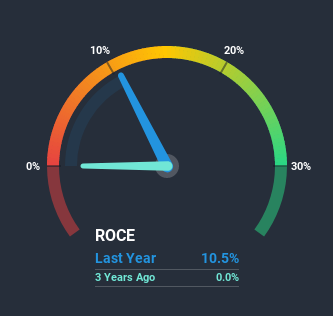- South Korea
- /
- Metals and Mining
- /
- KOSDAQ:A186230
What Do The Returns On Capital At Green Plus (KOSDAQ:186230) Tell Us?
If we want to find a potential multi-bagger, often there are underlying trends that can provide clues. Ideally, a business will show two trends; firstly a growing return on capital employed (ROCE) and secondly, an increasing amount of capital employed. Put simply, these types of businesses are compounding machines, meaning they are continually reinvesting their earnings at ever-higher rates of return. Having said that, from a first glance at Green Plus (KOSDAQ:186230) we aren't jumping out of our chairs at how returns are trending, but let's have a deeper look.
Return On Capital Employed (ROCE): What is it?
For those who don't know, ROCE is a measure of a company's yearly pre-tax profit (its return), relative to the capital employed in the business. The formula for this calculation on Green Plus is:
Return on Capital Employed = Earnings Before Interest and Tax (EBIT) ÷ (Total Assets - Current Liabilities)
0.11 = ₩6.5b ÷ (₩87b - ₩25b) (Based on the trailing twelve months to September 2020).
Therefore, Green Plus has an ROCE of 11%. On its own, that's a standard return, however it's much better than the 4.1% generated by the Metals and Mining industry.
See our latest analysis for Green Plus

In the above chart we have measured Green Plus' prior ROCE against its prior performance, but the future is arguably more important. If you're interested, you can view the analysts predictions in our free report on analyst forecasts for the company.
How Are Returns Trending?
Things have been pretty stable at Green Plus, with its capital employed and returns on that capital staying somewhat the same for the last one year. This tells us the company isn't reinvesting in itself, so it's plausible that it's past the growth phase. So don't be surprised if Green Plus doesn't end up being a multi-bagger in a few years time.
In Conclusion...
In summary, Green Plus isn't compounding its earnings but is generating stable returns on the same amount of capital employed. Yet to long term shareholders the stock has gifted them an incredible 171% return in the last three years, so the market appears to be rosy about its future. But if the trajectory of these underlying trends continue, we think the likelihood of it being a multi-bagger from here isn't high.
One more thing: We've identified 2 warning signs with Green Plus (at least 1 which is significant) , and understanding these would certainly be useful.
If you want to search for solid companies with great earnings, check out this free list of companies with good balance sheets and impressive returns on equity.
If you’re looking to trade Green Plus, open an account with the lowest-cost* platform trusted by professionals, Interactive Brokers. Their clients from over 200 countries and territories trade stocks, options, futures, forex, bonds and funds worldwide from a single integrated account. Promoted
New: Manage All Your Stock Portfolios in One Place
We've created the ultimate portfolio companion for stock investors, and it's free.
• Connect an unlimited number of Portfolios and see your total in one currency
• Be alerted to new Warning Signs or Risks via email or mobile
• Track the Fair Value of your stocks
This article by Simply Wall St is general in nature. It does not constitute a recommendation to buy or sell any stock, and does not take account of your objectives, or your financial situation. We aim to bring you long-term focused analysis driven by fundamental data. Note that our analysis may not factor in the latest price-sensitive company announcements or qualitative material. Simply Wall St has no position in any stocks mentioned.
*Interactive Brokers Rated Lowest Cost Broker by StockBrokers.com Annual Online Review 2020
Have feedback on this article? Concerned about the content? Get in touch with us directly. Alternatively, email editorial-team (at) simplywallst.com.
About KOSDAQ:A186230
Green Plus
Engages in the manufacturing and sale of aluminum products and greenhouse materials in South Korea and internationally.
Low risk with questionable track record.
Market Insights
Community Narratives




